PH Water Crisis: Kaliwa Dam Controversy Reveals Resilience

High in the misty embrace of the Sierra Madre mountains, there’s a story that goes beyond headlines and statistics—a story of resilience, tradition, and the indomitable human spirit.
It’s a story that begins in Daraitan, a village with about 5,000 residents, where the Dumagat people have called home for centuries.
As the rest of the world spins faster, here, time moves in harmony with the gentle flow of the Agos River. Maria Clara Dullas, president of the Dumagat Women of Sierra Madre, invites us into her world.
Daraitan’s residents have long been farmers, their families weaving an intricate tapestry of traditions and rituals that have endured for generations.
These traditions are not just ceremonies; they are a lifeline, protecting the community from illness and misfortune. The sacred white marble rock formations along the river serve as a sacred stage for these rituals.
However, looming over Daraitan like a silent giant is the Kaliwa Dam—a 230-foot behemoth that has cast a shadow of uncertainty.
Construction of the dam began last year, and once complete, it threatens to submerge the village, erasing cherished traditions and sacred lands.
A Gut-Wrenching Reality
For Maria Clara Dullas and her community, it’s a heart-wrenching reality. “It hurts us. It’s devastating,” she shares. Yet, the weight of the decision lies heavily upon their shoulders.
Without the dam, Philippine officials warn of a water crisis that could leave over 13 million people in the capital region parched starting next year.
Delfin Sespene, a supervising engineer, points to the region’s burgeoning population and the impending El Nino, a weather phenomenon threatening reduced rainfall.
“It will affect because there will be less rain for those dams that impound water for Metro Manila,” he explains. The Philippines, vulnerable to the impacts of climate change, faces a complex puzzle.
Angelo Kairos Torres Dela Cruz, with the Institute for Climate and Sustainable Cities, emphasizes the importance of balance. “It could have a role to play because it has scale, it’s bankable.
But that shouldn’t happen at the expense of other equally important issues – for example, Indigenous people’s rights, forests, and land degradation and so on,” he says.
The Kaliwa Dam, like many such projects worldwide, raises environmental concerns. Dams can emit greenhouse gases, intensify flooding, and disrupt river ecosystems.
In the midst of these complexities, the people of Daraitan find themselves at the crossroads of tradition and progress. The dam’s construction prompts a spectrum of emotions, from anxiety to anger, and the entire nation seems to be engaged in the debate.
Foreign financing, particularly from China, adds another layer of controversy to the project. It reflects the Philippines’ ongoing struggle to balance development and climate adaptation.
While climate change is not up for debate, how to weave it into the fabric of a developing nation’s plans remains a challenge.
Maria Clara Dullas and her community, however, speak from the heart. They feel excluded from the decisions that shape their future.
ALSO READ : China Takes the High Ground: Climate Monitoring on Himalayan Peak
The government offers compensation for relocation, but their plea is simple yet profound: “We just want what is ours, which is the land.”
It’s a uniquely human story—one that unfolds in the shadows of a dam, where resilience and hope stand taller than any construction project.



